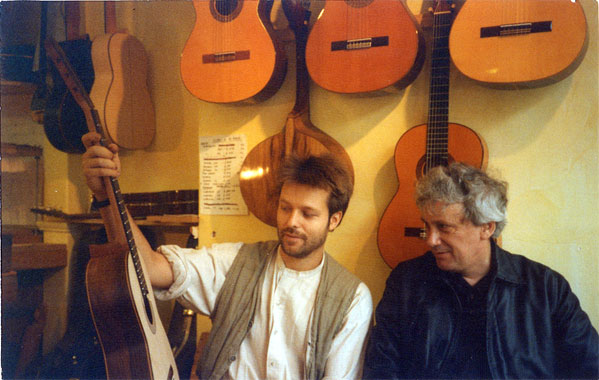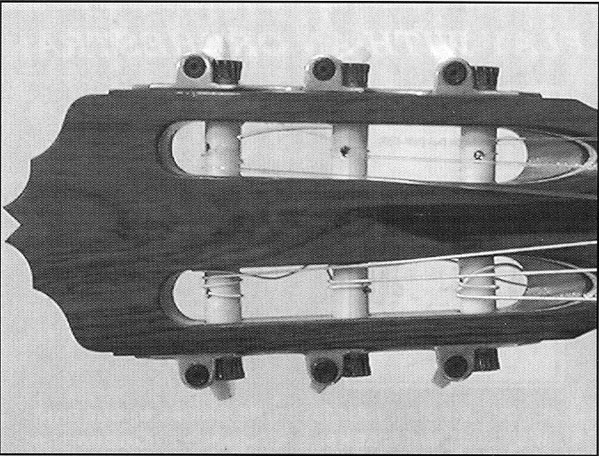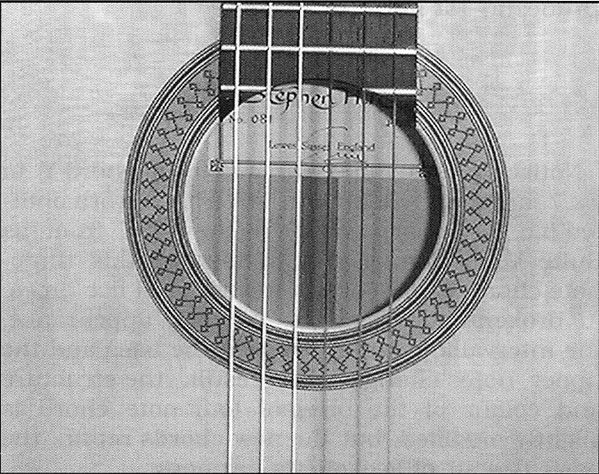Stephen Hill (luthier)
interviewed in 2000

England has several luthiers who are now world famous; and indeed, it may be true to say that there has arisen a “school” of English guitar makers whose instruments (as perhaps exemplified by those of Bryn Jones, or the late David Rubio) tend to have a “clear” sound, as opposed to a “romantic” sound like that of the traditional Spanish makers.
These luthiers, however, have almost all concentrated on classical instruments; and so I was particularly interested to be introduced recently to an informal group of makers, one of whom concentrates on flamenco guitars.
This loose collaboration comprises (in no particular order) Nick Benjamin (steel-string acoustic guitars and electric guitars); Richard Osborne (mandolins, mandolas & bouzoukis); Rohan Lowe (classical guitars); Stephen Hill (classical and flamenco guitars); Paul Aguilera (flamenco guitars and South American instruments); and Pablo Requena (classical and flamenco guitars).
As this is a Flamenco column, it’s clearly not the place to detail the instruments of all these makers. However, I did have the chance to play briefly, and was favourably impressed by, instruments from some of them; although I had no chance for a thorough test of any (except a bouzouki of Richard’s I liked so much that I bought it).
Given the aforementioned dearth of native luthiers, the British flamenco guitarist has had only three basic choices:
1) Buy an instrument second-hand
2) Buy a Spanish instrument from a British shop and pay the extra price incurred by duties and middlemen.
3) Go to Spain and incur the air fare and travel expenses, in addition to facing a possible wait of several years.
I’m therefore happy to be able to bring you a short interview with Stephen Hill, with especial reference to his flamenco guitars.

Stephen, how did you become interested in the guitar?
I started playing classical guitar when I was about eight years old, and continued till I was eighteen.
At sixteen I had left school (after failing abysmally all my exams), and got a job as an apprentice in a cabinet-making shop. I started taking guitar lessons again, and came across a very fine guitar by an English maker; and now having experience in woodwork, and looking at this fine guitar, I thought “Wow, this is woodwork, this is really fine!”, and the two things just sort of combined holistically, and set me on my path to be a maker.
So how did you get your start, was it with A.P. Sharpe’s book, like so many other people?

Not at all. The first real start was some terrible repairs I did on old Spanish instruments (not valuable ones, I hasten to add!).
But the first real making I did was a lute, with a kit from the Early Music Shop in London. So I built this lute over a period of about a year, on the kitchen table, steaming the ribs with a contraption I made from a kettle and a pipe.
In 1987, I went to the Totnes School of Guitar Making, In Devon. I did a short course there making a copy of a Stradivarius guitar in the Ashmolean Museum.
Then I discovered flamenco guitar, and this was really the kick to start me on my passion to go to Spain, where I spent quite a few months in the South. I did Paco Peña’s course in Córdoba, and really started to play a lot of flamenco guitar.
I built my first flamenco on my own in England, cypress and spruce, with pegs, and showed it to Paco Peña.
Then I continued on my spiritual tour of the South of Spain, hunting for the true culture of Flamenco. I took some lessons in Jerez, and went to the Ronda. Then finally I went up through the Alpujarras, and the last remnants of the Arab occupation.
While I was in Córdoba, I had the good fortune to spend some time with Manuel Reyes. I showed him my guitar, and he showed me his construction methods: we had a nice exchange. He gave me some addresses for wood, some contacts. It was nice to meet one of the really great maestros of Spain, and he became my ideal, as it were.
I then went to Granada, and felt very much at home there: there are a lot of guitar makers, as I’m sure you know. I felt a strong impulse to move to Granada, but it didn’t seem right at that time.
So I came back to England, and started building in a very small workshop here in Lewes. And I worked like that for about eight years before finally going mad and opening up a big shop in the town. I was selling to Paul Gregory at this time, and trying to convert all the local players to playing on my instruments.
Then the Lewes Guitar Makers started, and I began to foster makers in my workshop.
Are the Lewes Guitar Makers an actual business entity, or is it just a loose grouping?
It’s a loose grouping. We have a website, lewesguitarmakers.co.uk, and we buy a lot of materials together, and we meet many times for coffee and have a good exchange of ideas.
I’ve had about twenty students in a sort of informal school here; not making their living from the guitar, but there’s a lot of interest.
You said that Reyes became your ideal; do your methods of construction follow his?
In spirit only; because any maker working for long enough has to find his own way. Obviously, respect for the great makers is a very good starting point; but eventually you have to rely on your own intuition and experience to guide you.
So I would say my instruments are an amalgam of many influences.
What would you say are the distinguishing characteristics of your instruments?
My classical instruments have mainly spruce tops, and I find this produces the sound that I’m looking for—which is in a sense a fusion between the Spanish sound and the English sound. The latter I would characterise as being a very pure, very clean sound; its down side is that sometimes it can be too cold, and maybe thin. But it has great projection and clarity.
The Spanish sound has a more warm and sensual quality, and some guts as well; and I tend to feel that my instruments are a fusion of these characters. So that they have plenty of volume, clarity, balance, but with a warm sound.
I went to visit Romanillos, and bought a lot of spruce from 1971 from him, so I’m building some very nice instruments with this.

How many struts do you use?
I’m currently making with a seven-strut fan.
Torres strutting?
Yes, in a way, although at the moment I’m using two lower harmonic bars—a straight one at the soundhole, and also one which is set down towards the treble side, on both the classical and flamenco guitars. The strutting is treated very differently on each instrument; but I find that this method of having two bars means I can keep the top light and control the response very exactly. So the lower bar is not a big fat bar, it’s a thin, high bar. Which I find controls very nicely what I’m looking for.
With flamenco guitars, my aim is to produce a very traditional-sounding instrument: very percussive. But I love to have a real quality. Looking at Reyes’s instruments, he has an immensely powerful guitar; but they have a great quality, almost a mystical quality in the sound.
Where do you get your wood from?
A lot of my cypress I actually convert myself: I like to go through the whole aspect of sourcing my timber. I invariably go to the countries where the timber is produced. So I’ve had a lot of cypress from Spain, I’ve gained Southern French cypress (some huge old trees down in Avignon). Italian cypress as well, Greek cypress—each one has its own quality.
What about the tables?
I go over to Spain and buy tops there—Brazilian rosewood, too. I source timber in England, also, as there’s a good history of guitar-making here.
Do you usually have guitars in stock, or do you just make them to order?
I have to make them entirely to order. I never seem to have any guitars for stock, although I’m desperately trying to make them. But as soon as I do, someone comes in and buys them.
So you don’t supply them to shops?
Not at the moment, no.
So that if someone wants a guitar, they have to come to you here?
Yes. Occasionally I will supply to shops—I’m building a guitar at the moment for Guitar Salon International—but in general, with my private orders, I can’t manage it.
What would one of your instruments cost, typically?
A traditional flamenco instrument, with either pegs or machine heads, is about £1,800. For Indian rosewood classical guitar, £1,950. Then for Brazilian rosewood, £2,200.
If you want to upgrade to Rogers machine heads, or Northumbrian machine heads (which I’m using at the moment), then you can add another £250.
So for the top model, you’re looking at nearly £2,500. My prices are going to go up at the end of this year, but that’s the price at the moment.

A new guitar is always stiff. How long would you say it takes your guitars to reach their best?
Well, the first year is always a difficult time. It depends how it’s stored, how it’s played and how it’s treated. It’s perhaps a bit like a baby, characterised by a lot of up and down—some times it sounds really great, other times perhaps a little bit flat.
But after about a year, my instruments hold their sound, so they become less temperamental. Those I built fifteen years ago sound fantastic now.
I used to build quite a weighty top; and these took quite a long time to play through, about two years. But I’m building it thinner now, which I find gives me more control, and it’s reaching its level in about a year. And holds it very well after that.
What about the bridge?
The length is very important to me. Also the height of the tie-block and the sound-block. And the wings, and the way you do the facets at the end. In Reyes’s guitars they’re very short, and in Romanillos’s they’re very long. So I tend to couple the bridge with the top, to marry my timbers to produce a holistic instrument. You have to look at each timber for its characteristics, and then you have to match all the timbers. If you’re haphazard, your guitars are haphazard.
Guitar-making is a science; but the best makers approach their work pragmatically, building up on their experience. I believe that the intuitive mind is very important, to sense when changes are needed. If you just rely on what you’ve done for years, then I believe your instruments won’t reach the peak you’re looking for. If you’re complacent, then you start the long gradual decline.
What would be the current wait for someone who wanted one of your guitars?
I would say, round about a year.
I find I have a number orders where people have acquired a classical or flamenco guitar, and they want to have its brother or sister—two orders for flamencos I’m building, and each person owns a classical guitar. And they say, Can you make it in a year and a half? So I put that in my waiting book, I’ve got full areas and then free areas, off to about three years time.
But if you ordered from me today, you’d expect to wait about a year.
Update 2021
Stephen now lives in Granada province, in Spain. His website is www.stephenhillguitars.com.
